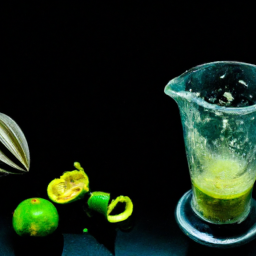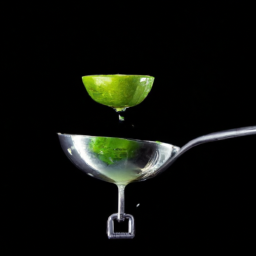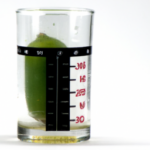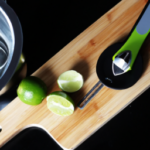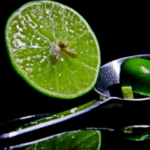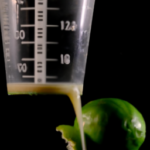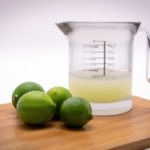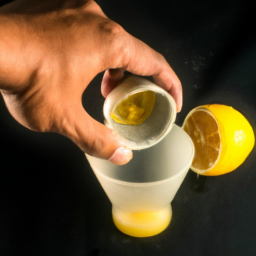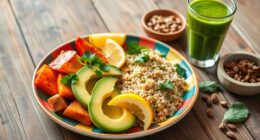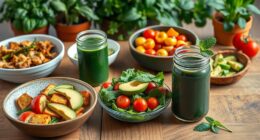I have always been intrigued by the tangy and citrusy flavor of lime juice. It is a versatile ingredient that can be used in a variety of recipes, whether they are sweet or savory, from cocktails to marinades. Whenever I am cooking, I often ponder, ‘How much juice can one lime yield?’
The answer is not straightforward, as it depends on several factors that affect the amount of juice a lime can yield.
Firstly, the variety of lime and its ripeness can significantly impact the amount of juice it contains. For example, the Persian lime, which is the most common type found in grocery stores, tends to yield more juice than the Key lime, which has a thinner skin and is sweeter.
Additionally, a ripe lime will be juicier than an unripe one, as the juice sacs inside the fruit are fuller and more developed. Other factors that can affect the amount of juice in a lime include its size, shape, and even the season it was harvested.
In this article, we will explore all the variables that affect lime juice yield and provide you with tips and tricks to get the most juice out of your limes.
Key Takeaways
- The amount of juice in a lime depends on variety, ripeness, size, shape, and season.
- Persian limes yield more juice than Key limes.
- Ripe limes are juicier than unripe ones.
- Rolling and microwaving the lime before juicing can help yield more juice.
Factors that Affect the Amount of Juice in a Lime
You might be surprised by how much juice you can get out of a lime, depending on factors like ripeness and temperature. Factors affecting lime juice extraction include the size of the fruit, its maturity, and the amount of pressure applied when squeezing.
Limes that are larger and more mature tend to have more juice than those that are smaller and underdeveloped. The amount of pressure applied during juice extraction can also affect the amount of juice produced.
The chemistry behind lime juice production is based on a combination of citric acid and water, which are the primary constituents of the fruit. As the lime matures, the amount of citric acid increases, which contributes to its sour taste.
The amount of juice produced is also influenced by temperature, with limes that are kept at warmer temperatures generally producing more juice than those that are kept in cooler conditions. Understanding these factors can help you choose the right limes for your recipe, ensuring that you get the most out of your citrus fruits.
How to Choose the Right Limes for Your Recipe
When selecting limes for your recipe, it’s important to keep in mind that the level of acidity can vary greatly between different types of citrus fruits.
Lime varieties, such as Key lime and Persian lime, have different levels of acidity and sweetness, which can affect the overall taste of your dish.
In general, Key limes are more acidic and have a stronger flavor, while Persian limes are sweeter and have a milder taste.
Another factor to consider when choosing limes for your recipe is the ripeness level.
Limes that are too ripe may have a bitter taste and less juice, while unripe limes may not be as flavorful.
Look for limes that are firm and have a bright green color.
If the skin is yellow, it may be overripe and have less juice.
By choosing the right lime variety and ripeness level, you can ensure that your dish has the perfect balance of acidity and flavor.
When it comes to juicing a lime, there are a few tools you need to make the process easier and more efficient.
Tools You Need to Juice a Lime
To get the perfect amount of tanginess in your dish, it’s essential to have the right tools for juicing a lime. There are many types of juicers available in the market, but the two most commonly used for lime juice are manual and electric juicers.
Manual juicers are handheld and require physical pressure to extract the juice from the lime. These are perfect for small amounts of juice and are easy to clean.
Electric juicers are more efficient and can extract juice quickly and in large quantities. However, they tend to be more expensive and require more cleaning than manual juicers.
Another thing to keep in mind is that you can substitute lime juice with other citrus fruits like lemons or oranges if you don’t have any limes on hand.
In the next section, we’ll discuss the different ways to juice a lime.
Different Ways to Juice a Lime
If you’re looking to add a zesty kick to your dish, there are a variety of methods for juicing a lime that you can choose from. One of the most popular ways is to use a lime squeezer, which comes in several types. The handheld lime squeezer is the most common, but there are also electric versions that can handle larger volumes. Regardless of the type, using a lime squeezer ensures that you get all the juice out of the lime, without the need to use your hands or a fork.
Another option is to use a citrus press, which is similar to a lime squeezer but has a larger capacity and can be used for other citrus fruits as well. This is a great option if you need to juice a lot of limes at once. If you prefer a more hands-on approach, you can use a fork to extract the juice, although this method is less efficient. Regardless of the method you choose, it’s important to keep in mind the citric acid content of limes, which can vary depending on the size and ripeness of the lime.
To ensure accuracy in your recipes, it’s important to measure the lime juice carefully. In the next section, we’ll look at how to measure lime juice for recipes.
How to Measure Lime Juice for Recipes
Measuring the amount of lime juice for recipes is essential for ensuring the perfect balance of flavor in your dish. When it comes to measuring lime juice, accuracy is key.
The amount of juice in one lime can vary depending on factors such as the size, ripeness, and juiciness of the fruit. Therefore, it’s important to use measuring tools to ensure the right amount of lime juice is added to your recipe.
If you’re unable to obtain fresh limes for your recipe, it’s possible to substitute with bottled lime juice. However, it’s important to note that bottled lime juice may not provide the same flavor and freshness as fresh lime juice. When using bottled juice, make sure to check the label for the amount of juice per serving, and adjust the amount used accordingly.
With accurate measurements, you can ensure that your dish has the perfect balance of lime flavor.
To get the most juice out of your lime, there are a few tips and tricks to keep in mind. Stay tuned for the next section where I’ll share some helpful techniques for juicing limes effectively.
Tips for Getting the Most Juice Out of Your Lime
When measuring lime juice for recipes, it’s important to get the most juice out of your lime. From personal experience, I’ve found that there are alternative methods to just squeezing the lime that can help yield more juice.
One method is to roll the lime on a hard surface before cutting it in half. This helps break down the membranes inside the lime that hold the juice, making it easier to extract. Another method is to microwave the lime for 10-15 seconds before juicing it. This helps break down the cell walls and release more juice.
However, there are also common mistakes people make when trying to get the most juice out of their lime. One mistake is not using enough pressure when squeezing the lime. It’s important to use your hand to apply pressure to the lime while squeezing it to extract as much juice as possible.
Another mistake is not using a juicer or strainer to remove any seeds or pulp from the juice. This can affect the taste and texture of your recipe. By using these alternative methods and avoiding common mistakes, you can maximize your lime juice yield for your recipes.
To ensure you have lime juice on hand for future use, it’s important to store it properly.
Storing Lime Juice for Later Use
When it comes to storing lime juice for later use, I usually use refrigeration or freezing.
I prefer refrigerating lime juice in an airtight container as it can last up to a week. I make sure to label the container with the date to ensure maximum freshness.
Freezing lime juice is also an option, but I make sure to use freezer-safe containers and label them with the date as well.
Refrigeration
Properly preserving your lime juice by placing it in the fridge can prolong its potency and prevent spoilage. Lime juice preservation is crucial because it’s a versatile ingredient that can be used in various recipes, from cocktails to marinades. It’s also an excellent alternative to other sources of lime flavor, such as lime zest or lime extract.
When storing lime juice in the fridge, it’s best to use an airtight container to prevent oxidation and contamination. It’s also essential to keep the juice away from direct sunlight and heat sources, which can affect its quality. Properly stored lime juice can last for up to two weeks in the fridge, making it an excellent addition to your cooking arsenal.
Transitioning to the subsequent section about ‘freezing,’ it’s worth noting that while freezing is another method of preserving lime juice, it can alter its taste and texture. So, if you want to maintain the natural flavor and texture of your lime juice, it’s best to store it in the fridge.
Freezing
Now that we’ve covered refrigeration as a method to keep lime juice fresh, let’s talk about freezing. Freezing is another way to preserve the freshness of lime juice.
It involves placing freshly squeezed lime juice into a freezer-safe container and freezing it until ready to use. Freezing lime juice is a great alternative for those who don’t have access to fresh limes or who want to have lime juice on hand at all times.
It’s important to note that freezing can affect the texture of the juice. Once thawed, the juice may be slightly different in texture than freshly squeezed juice. Despite this, frozen lime juice can still be used in cocktails, marinades, and dressings.
It’s a convenient way to have lime juice readily available and can be used in a variety of ways.
As we’ve discussed the different methods of preserving lime juice, let’s move on to the various recipes that use lime juice.
Recipes that Use Lime Juice
I love using lime juice in my cooking and cocktails, and it’s amazing how versatile this citrus fruit can be. Lime juice can add a bright, tangy flavor to savory dishes like ceviche, tacos, and grilled meats. It’s also a key ingredient in classic cocktails like margaritas and daiquiris.
But lime juice can also be used in desserts, like key lime pie, lime sorbet, and lime cheesecake. Adding a refreshing acidity that balances out sweetness.
Cocktails
When mixing a refreshing mojito, don’t forget that half a lime typically yields around 1 ounce of lime juice. This important measurement ensures that your cocktail will have the perfect balance of sweet and sour flavors.
Lime juice is a crucial ingredient in many cocktail recipes, providing a tart and acidic element that balances the sweetness of other ingredients. Lime garnishes are also a popular addition to cocktails, adding a pop of color and a hint of citrus aroma to the drink.
In addition to cocktails, lime juice can also be used in savory dishes. From marinades to salad dressings, lime juice adds a bright and zesty flavor to a variety of dishes.
In the next section, we will explore the many ways that lime juice can be used in cooking, including some delicious recipes that you can try at home.
Savory Dishes
To add a zesty kick to your savory dishes, try incorporating fresh lime zest into your recipes. Did you know that just one tablespoon of lime zest contains more vitamin C than an entire lime?
Lime zest can enhance the umami flavor of your dishes, especially if you’re cooking with seafood or chicken. Here are some pairing suggestions to get you started:
- Grilled shrimp with a lime zest and chili flake marinade
- Lime and cilantro rice to accompany your favorite Mexican dishes
- A Vietnamese-style banh mi sandwich with pickled vegetables and a lime mayo dressing
Not only does lime zest add a burst of flavor to your dishes, but it also packs a nutritional punch. So next time you’re cooking up a storm in the kitchen, don’t forget to add a little lime zest for a boost of vitamin C.
As we move into the next section about desserts, keep in mind that lime can also add a tangy sweetness to your baked goods.
Desserts
Indulge in a sweet treat by incorporating the tangy flavor of lime into your desserts, enhancing the richness of flavors and adding a refreshing twist to classic recipes. Lime juice is an excellent addition to desserts because it balances the sweetness and provides a unique flavor profile. If you’re out of fresh limes, don’t worry, there are lime juice substitutes you can use. However, fresh lime juice is always the best option as it has a more robust and authentic flavor.
Here are some creative lime dessert recipes you can try:
| Dessert | Ingredients | Instructions |
|---|---|---|
| Key Lime Pie | Graham cracker crust, sweetened condensed milk, key lime juice, egg yolks | Mix condensed milk, egg yolks, and lime juice. Pour mixture into crust and bake for 15 minutes. Let it cool and refrigerate for 2 hours. |
| Lime Bars | Flour, sugar, butter, eggs, lime juice, powdered sugar | Mix flour, sugar, and butter. Bake for 15 minutes. Mix eggs, lime juice, and sugar. Pour mixture over baked crust and bake for 20 minutes. Dust with powdered sugar. |
| Lime Cheesecake | Cream cheese, graham cracker crust, sugar, lime juice, eggs | Mix cream cheese, sugar, and lime juice. Add eggs and pour mixture into crust. Bake for 30-35 minutes and refrigerate for 2 hours. |
| Lime Sorbet | Water, sugar, lime zest, lime juice | Bring water and sugar to a boil. Add lime zest and simmer for 5 minutes. Let it cool and stir in lime juice. Freeze mixture in an ice cream maker. |
Adding lime juice to your desserts not only adds a burst of flavor but also provides health benefits. It’s an excellent source of vitamin C, which helps boost your immune system and fight off infections. In the next section, we’ll explore the various health benefits of lime juice in more detail.
Health Benefits of Lime Juice
You think you’re just adding a splash of flavor to your drink, but little do you know, that single lime is packed with health benefits.
Lime juice is a great source of Vitamin C, which is essential in boosting your immune system and preventing illnesses. It also contains flavonoids, which have antioxidant properties that help protect your cells from damage caused by free radicals.
Moreover, lime juice is known to have anti-inflammatory properties that can help reduce joint pain and prevent chronic diseases such as heart disease and cancer. It also aids in digestion and can be used in various recipes to add flavor and health benefits.
From salad dressings to marinades, lime juice is a versatile ingredient that can enhance the taste and nutritional value of your meals. So don’t be afraid to add a little lime juice to your next dish or drink, and reap the benefits it has to offer.
Frequently Asked Questions
How long does lime juice last in the fridge after it has been squeezed?
I store leftover lime juice in an airtight container in the fridge for up to 2 weeks. Freezing is also an option, but the texture may change. Uses for leftover lime juice include marinades, dressings, and cocktails.
Can you freeze lime juice for later use?
Yes, you can freeze lime juice for later use. However, the benefits of using fresh lime juice are lost after freezing. To properly store lime juice, use an airtight container and freeze for up to 6 months.
Are there any types of limes that are better for juicing than others?
Some lime juice types are better for juicing than others. Key limes have more juice and a stronger flavor, while Persian limes are easier to juice and have a milder taste. Proper juicing techniques can also increase yield.
Is it necessary to remove the seeds from the lime before juicing?
Removing seeds from limes before juicing is not necessary but can improve the texture of the juice. It does not affect the taste significantly. Using a juicer can also help avoid seeds.
Can lime juice be substituted for lemon juice in recipes?
Wow, lime and lemon juices are like two different worlds! While they share some similarities, their flavor profiles are distinct. Lime juice can be substituted for lemon juice in recipes, but keep in mind the flavor differences. Scientifically speaking, lime juice contains more citric acid and less sugar than lemon juice.
Conclusion
In conclusion, knowing how much lime juice is in one lime can make all the difference in your recipe. As I’ve learned, factors such as the size and ripeness of the lime can affect the amount of juice you get. However, with the right tools and techniques, you can maximize the amount of juice you extract from your limes.
Remember to choose fresh, plump limes that are heavy for their size, and to use a quality juicer or reamer to extract the juice. And don’t forget to properly measure your lime juice for recipes, as accuracy is key.
So go ahead and indulge in the tangy, zesty flavor of lime juice in your favorite recipes, knowing that you have the knowledge and skills to get the most out of your limes. As the saying goes, when life gives you limes, make limeade.
With the tips and tricks you’ve learned, you can make the most delicious and refreshing limeade possible. So go forth and enjoy the benefits of this citrus fruit, from its bright flavor to its health benefits. You’ll be glad you did.
Ilana has been a vegan for over 10 years. She originally made the switch for health reasons, but soon found herself becoming more and more passionate about the ethical and environmental implications of a vegan lifestyle. Ilana is the author of The Graceful Kitchen, a blog all about veganism. She loves to cook up delicious and nutritious vegan meals, and share her recipes with others who are interested in leading a cruelty-free life. Ilana is also a strong advocate for using whole foods as the foundation of a healthy diet, and believes that going vegan is one of the best ways to achieve this.
